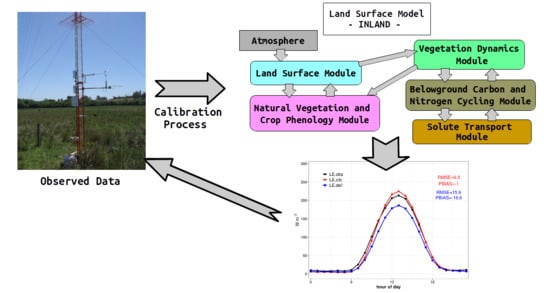Energy and CO2 Fluxes over Native Fields of Southern Brazil through Multi-Objective Calibration of INLAND Model
Abstract
1. Introduction
2. Materials and Methods
2.1. Description of the INLAND Surface Model
2.1.1. NEE Modeling
2.1.2. Modeling Soil Water Movement
2.1.3. Distribution of Surface Energy
2.2. Experimental Site
2.2.1. Meteorological and Flux Data
2.2.2. Model Initialization: Soil Moisture Spin-up
2.3. Calibration: Hierarchical and Multi-Objective Approach
2.4. Simulations Design And Analyses
3. Results and Discussion
3.1. Weather Conditions
3.2. Calibration
3.3. Discussion
3.4. Validation and Annual Estimation
4. Conclusions
Author Contributions
Funding
Acknowledgments
Conflicts of Interest
References
- Bonan, G.B. Forests and Climate Change: Forcings, Feedbacks, and the Climate Benefits of Forests. Science 2008, 320, 1444–1449. [Google Scholar] [CrossRef]
- Pitman, A.J. The evolution of, and revolution in, land surface schemes designed for climate models. Int. J. Climatol. 2003, 23, 479–510. [Google Scholar] [CrossRef]
- VanLoocke, A.; Twine, T.E.; Zeri, M.; Bernacchi, C.J. A regional comparison of water use efficiency for miscanthus, switchgrass and maize. Agric. For. Meteorol. 2012, 164, 82–95. [Google Scholar] [CrossRef]
- Zhang, K.; Castanho, A.D.d.A.; Galbraith, D.R.; Moghim, S.; Levine, N.M.; Bras, R.L.; Coe, M.T.; Costa, M.H.; Malhi, Y.; Longo, M.; et al. The fate of Amazonian ecosystems over the coming century arising from changes in climate, atmospheric CO2, and land use. Glob. Chang. Biol. 2015, 21, 2569–2587. [Google Scholar] [CrossRef]
- Chen, M.; Willgoose, G.R.; Saco, P.M. Evaluation of the hydrology of the IBIS land surface model in a semi-arid catchment. Hydrol. Process. 2015, 29, 653–670. [Google Scholar] [CrossRef]
- Gupta, H.V.; Bastidas, L.A.; Sorooshian, S.; Shuttleworth, W.J.; Yang, Z.L. Parameter estimation of a land surface scheme using multicriteria methods. J. Geophys. Res. Atmos. 1999, 104, 19491–19503. [Google Scholar] [CrossRef]
- Groenendijk, M.; Dolman, A.; van der Molen, M.; Leuning, R.; Arneth, A.; Delpierre, N.; Gash, J.; Lindroth, A.; Richardson, A.; Verbeeck, H.; et al. Assessing parameter variability in a photosynthesis model within and between plant functional types using global Fluxnet eddy covariance data. Agric. For. Meteorol. 2011, 151, 22–38. [Google Scholar] [CrossRef]
- da Rocha, H.R.; Nobre, C.A.; Bonatti, J.P.; Wright, I.R.; Sellers, P.J. A vegetation-atmosphere interaction study for Amazonia deforestation using field data and a ‘single column’ model. Q. J. R. Meteorol. Soc. 1996, 122, 567–594. [Google Scholar]
- Fischer, G.R.; Costa, M.H.; Murta, F.Z.; Malhado, A.C.; Aguiar, L.J.; Ladle, R.J. Multi-site land surface model optimization: An exploration of objective functions. Agric. For. Meteorol. 2013, 182, 168–176. [Google Scholar] [CrossRef]
- Boyle, D.P.; Gupta, H.V.; Sorooshian, S. Toward improved calibration of hydrologic models: Combining the strengths of manual and automatic methods. Water Resour. Res. 2000, 36, 3663–3674. [Google Scholar] [CrossRef]
- Vrugt, J.A.; Robinson, B.A. Improved evolutionary optimization from genetically adaptive multimethod search. Proc. Natl. Acad. Sci. USA 2007, 104, 708–711. [Google Scholar] [CrossRef]
- Xue, L.; Pan, Z. Ensemble calibration and sensitivity study of a surface CO2 flux scheme using an optimization algorithm. J. Geophys. Res. Atmos. 2008, 113. [Google Scholar] [CrossRef]
- Varejão, C.G.; Costa, M.H.; Camargo, C.C.S. A multi-objective hierarchical calibration procedure for land surface/ecosystem models. Inverse Probl. Sci. Eng. 2013, 21, 357–386. [Google Scholar] [CrossRef]
- Rosolem, R.; Gupta, H.V.; Shuttleworth, W.J.; de Gonçalves, L.G.G.; Zeng, X. Towards a comprehensive approach to parameter estimation in land surface parameterization schemes. Hydrol. Process. 2012, 27, 2075–2097. [Google Scholar] [CrossRef]
- Wöhling, T.; Samaniego, L.; Kumar, R. Evaluating multiple performance criteria to calibrate the distributed hydrological model of the upper Neckar catchment. Environ. Earth Sci. 2013, 69, 453–468. [Google Scholar] [CrossRef]
- Shafii, M.; Tolson, B.A. Optimizing hydrological consistency by incorporating hydrological signatures into model calibration objectives. Water Resour. Res. 2015, 51, 3796–3814. [Google Scholar] [CrossRef]
- Foley, J.A.; Prentice, I.C.; Ramankutty, N.; Levis, S.; Pollard, D.; Sitch, S.; Haxeltine, A. An integrated biosphere model of land surface processes, terrestrial carbon balance, and vegetation dynamics. Glob. Biogeochem. Cycles 1996, 10, 603–628. [Google Scholar] [CrossRef]
- Costa, M.H.; Pires, G.F. Effects of Amazon and Central Brazil deforestation scenarios on the duration of the dry season in the arc of deforestation. Int. J. Climatol. 2010, 30, 1970–1979. [Google Scholar] [CrossRef]
- Castanho, A.D.A.; Coe, M.T.; Costa, M.H.; Malhi, Y.; Galbraith, D.; Quesada, C.A. Improving simulated Amazon forest biomass and productivity by including spatial variation in biophysical parameters. Biogeosciences 2013, 10, 2255–2272. [Google Scholar] [CrossRef]
- Castanho, A.D.A.; Galbraith, D.; Zhang, K.; Coe, M.T.; Costa, M.H.; Moorcroft, P. Changing Amazon biomass and the role of atmospheric CO2 concentration, climate, and land use. Glob. Biogeochem. Cycles 2016, 30, 18–39. [Google Scholar] [CrossRef]
- Pires, G.F.; Abrahão, G.M.; Brumatti, L.M.; Oliveira, L.J.; Costa, M.H.; Liddicoat, S.; Kato, E.; Ladle, R.J. Increased climate risk in Brazilian double cropping agriculture systems: Implications for land use in Northern Brazil. Agric. For. Meteorol. 2016, 228–229, 286–298. [Google Scholar] [CrossRef]
- Restrepo-Coupe, N.; Levine, N.M.; Christoffersen, B.O.; Albert, L.P.; Wu, J.; Costa, M.H.; Galbraith, D.; Imbuzeiro, H.; Martins, G.; da Araujo, A.C.; et al. Do dynamic global vegetation models capture the seasonality of carbon fluxes in the Amazon basin? A data-model intercomparison. Glob. Chang. Biol. 2017, 23, 191–208. [Google Scholar] [CrossRef]
- Dionizio, E.A.; Costa, M.H.; Castanho, A.D.D.A.; Pires, G.F.; Marimon, B.S.; Marimon-Junior, B.H.; Lenza, E.; Pimenta, F.M.; Yang, X.; Jain, A.K. Influence of climate variability, fire and phosphorus limitation on vegetation structure and dynamics of the Amazon-Cerrado border. Biogeosciences 2018, 15, 919–936. [Google Scholar] [CrossRef]
- Figueroa, S.N.; Bonatti, J.P.; Kubota, P.Y.; Grell, G.A.; Morrison, H.; Barros, S.R.M.; Fernandez, J.P.R.; Ramirez, E.; Siqueira, L.; Luzia, G.; et al. The Brazilian Global Atmospheric Model (BAM): Performance for Tropical Rainfall Forecasting and Sensitivity to Convective Scheme and Horizontal Resolution. Weather Forecast. 2016, 31, 1547–1572. [Google Scholar] [CrossRef]
- Cunha, A.P.M.A.; Alvalá, R.C.S.; Sampaio, G.; Shimizu, M.H.; Costa, M.H. Calibration and Validation of the Integrated Biosphere Simulator (IBIS) for a Brazilian Semiarid Region. J. Appl. Meteorol. Climatol. 2013, 52, 2753–2770. [Google Scholar] [CrossRef]
- Overbeck, G.E.; Müller, S.C.; Fidelis, A.; Pfadenhauer, J.; Pillar, V.D.; Blanco, C.C.; Boldrini, I.I.; Both, R.; Forneck, E.D. Brazil’s neglected biome: The South Brazilian Campos. Perspect. Plant Ecol. Evol. Syst. 2007, 9, 101–116. [Google Scholar] [CrossRef]
- Pillar, V.P.; Muller, S.C.; Castilhos, Z.M.S.; Jacques, A.V.A. Campos Sulinos-Conservação e uso Sustentável da Biodiversidade; MMA: Brasília, Brazil, 2009; p. 403. [Google Scholar]
- Boldrini, I.I.; Eggers, L. Vegetação campestre do sul do Brasil: Dinâmica de espécies a exclusão do gado. Acta Bot. Bras. 1996, 10, 37–50. [Google Scholar] [CrossRef]
- Kucharik, C.J.; Foley, J.A.; Delire, C.; Fisher, V.A.; Coe, M.T.; Lenters, J.D.; Young-Molling, C.; Ramankutty, N.; Norman, J.M.; Gower, S.T. Testing the performance of a dynamic global ecosystem model: Water balance, carbon balance, and vegetation structure. Glob. Biogeochem. 2000, 14, 795–825. [Google Scholar] [CrossRef]
- Farquhar, G.D.; vonCaemmerer, S.; Berry, J.A. A biogeochemical model of photosynthetic CO2 assimilation in leaves of C3 species. Planta 1980, 149, 78–90. [Google Scholar] [CrossRef]
- Collatz, G.J.; Ball, J.T.; Grivet, C.; Berry, J.A. Physiological and environmental regulation of stomatal conductance, photosynthesis and transpiration: A model that includes a laminar boundary layer. Agric. For. Meteorol. 1991, 54, 107–136. [Google Scholar] [CrossRef]
- Collatz, G.J.; Ribas-Carbo, M.; Berry, J.A. Coupled Photosynthesis-Stomatal Conductance Model for Leaves of C4 Plants. Aust. J. Plant Physiol. 1992, 19, 519–538. [Google Scholar] [CrossRef]
- Griffis, T.; Baker, J.; Zhang, J. Seasonal dynamics and partitioning of isotopic CO2 exchange in a C3/C4 managed ecosystem. Agric. For. Meteorol. 2005, 132, 1–19. [Google Scholar] [CrossRef]
- Parton, W.J.; Schimel, D.S.; Cole, C.V.; Ojima, D.S. Analysis of factors controlling soil organic matter levels in Great Plains grasslands. Soil Sci. Soc. Am. J. 1987, 51, 1173–1179. [Google Scholar] [CrossRef]
- Verberne, E.L.J.; Hassink, J.; Willigen, P.; Groot, J.J.R.; van Veen, J.A. Modelling organic matter dynamics in different soils. Njas Wagening. J. Life Sci. 1990, 38, 221–238. [Google Scholar]
- Parton, W.J.; Scurlock, J.M.O.; Ojima, D.S.; Gilmanov, T.G.; Scholes, R.J.; Schimel, D.S.; Kirchner, T.; Menaut, J.C.; Seastedt, T.; Garcia Moya, E.; et al. Observations and modeling of biomass and soil organic matter dynamics for the grassland biome worldwide. Glob. Biogeochem. Cycles 1993, 7, 785–809. [Google Scholar] [CrossRef]
- Lloyd, J.; Taylor, J.A. On the Temperature Dependence of Soil Respiration. Funct. Ecol. 1994, 8, 315–323. [Google Scholar] [CrossRef]
- Darcy, H. Les Fontaines Publiques de la Ville de Dijon. Exposition et Application des Principes à Suivre et des Formules à Employer Dans les Questions de Distribution D’eau: Ouvrage Terminé par un Appendice Relatif aux Fournitures D’eau de Plusieurs Villes au Filtrage des Eaux et à la Fabrication des Tuyaux de Fonte, de Plomb, de Tole et de Bitume; Dalmont: Paris, France, 1856. [Google Scholar]
- Campbell, G.S.; Norman, J.M. An Introduction to Environmental Biophysic, 2nd ed.; Springer: New York, NY, USA, 1998; p. 286. [Google Scholar]
- Jackson, R.B.; Mooney, H.A.; Schulze, E.D. A global budget for fine root biomass, surface ande nutrient contents. Water Resour. Res. 1997, 94, 7362–7366. [Google Scholar]
- Sellers, P.J.; Mintz, Y.; Sud, Y.; Dalch, A. A simple biosphere model (SiB) for use withingeneral circulation model. J. Atmos. Sci. 1986, 43, 505–531. [Google Scholar] [CrossRef]
- Bonan, G.B. Land-atmosphere CO2 exchange simulated by a landsurface process modelcoupled to anatmospheric general circulation model. J. Geophys. Res. 1995, 100, 2817–2831. [Google Scholar] [CrossRef]
- Santos, A.B.d.; Quadros, F.L.F.d.; Confortin, A.C.C.; Seibert, L.; Ribeiro, B.S.M.R.; Severo, P.d.O.; Casanova, P.T.; Machado, G.K.G. Morfogênese de gramíneas nativas do Rio Grande do Sul (Brasil) submetidas a pastoreio rotativo durante primavera e verão. CiêNcia Rural. 2014, 44, 97–103. [Google Scholar] [CrossRef]
- Quadros, F.L.F.d.; Pillar, V.D.P. Dinâmica vegetacional em pastagem natural submetida a tratamentos de queima e pastejo. CiêNcia Rural. 2001, 31, 863–868. [Google Scholar] [CrossRef]
- IBGE. Instituto Brasileiro de Geografia e Estatística. 2002. Available online: http://mapas.ibge.gov.br/tematicos/solos (accessed on 25 August 2019).
- Rubert, G.C.; Roberti, D.R.; Pereira, L.S.; Quadros, F.L.F.; Campos Velho, H.F.d.; Leal de Moraes, O.L. Evapotranspiration of the Brazilian Pampa Biome: Seasonality and Influential Factors. Water 2018, 10, 1864. [Google Scholar] [CrossRef]
- Kottek, M.; Grieser, J.; Beck, C.; Rudolf, B.; Rubel, F. World Map of the Köppen-Geiger climate classification updated. Meteorol. Z. 2006, 15, 259–263. [Google Scholar] [CrossRef]
- Kurtzman, D.; Navon, S.; Morin, E. Improving interpolation of daily precipitation for hydrologic modelling: Spatial patterns of preferred interpolators. Hydrol. Process. 2009, 23, 3281–3291. [Google Scholar] [CrossRef]
- Baldocchi, D.D.; Hincks, B.B.; Meyers, T.P. Measuring Biosphere-Atmosphere Exchanges of Biologically Related Gases with Micrometeorological Methods. Ecology 1988, 69, 1331–1340. [Google Scholar] [CrossRef]
- Wilson, K.; Goldstein, A.; Falge, E.; Aubinet, M.; Baldocchi, D.; Berbigier, P.; Bernhofer, C.; Ceulemans, R.; Dolman, H.; Field, C.; et al. Energy balance closure at FLUXNET sites. Agric. For. Meteorol. 2002, 113, 223–243. [Google Scholar] [CrossRef]
- Imbuzeiro, H.M.A. Calibração do Modelo IBIS na Floresta Amazônica Usando Múltiplos Sítios. Mestrado em meteorologia agrícola, Universidade Federal de Viçosa, Viçosa, Brazil. 2005. Available online: https://www.locus.ufv.br/handle/123456789/8163 (accessed on 16 November 2020).
- de Gonçalves, L.G.G.; Borak, J.S.; Costa, M.H.; Saleska, S.R.; Baker, I.; Restrepo-Coupe, N.; Muza, M.N.; Poulter, B.; Verbeeck, H.; Fisher, J.B.; et al. Overview of the Large-Scale Biosphere–Atmosphere Experiment in Amazonia Data Model Intercomparison Project (LBA-DMIP). Agric. For. Meteorol. 2013, 182, 111–127. [Google Scholar] [CrossRef]
- Robock, A.; Schlosser, C.A.; Vinnikov, K.Y.; Speranskaya, N.A.; Entin, J.K.; Qiu, S. Evaluation of the AMIP soil moisture simulations. Glob. Planet. Chang. 1998, 19, 181–208. [Google Scholar] [CrossRef]
- R Core Team. R: A Language and Environment for Statistical Computing; R Foundation for Statistical Computing: Vienna, Austria, 2020. [Google Scholar]
- Access to land, livestock production and ecosystem conservation in the Brazilian Campos biome: The natural grasslands dilemma. Livest. Sci. 2009, 120, 158–162. [CrossRef]
- Zimmer, T.; Buligon, L.; de Arruda Souza, V.; Romio, L.C.; Roberti, D.R. Influence of clearness index and soil moisture in the soil thermal dynamic in natural pasture in the Brazilian Pampa biome. Geoderma 2020, 378, 114582. [Google Scholar] [CrossRef]
- Maayar, M.E.; Price, D.T.; Delire, C.; Foley, J.A.; Black, T.A.; Bessemoulin, P. Validation of the Integrated Biosphere Simulator over Canadian deciduous and coniferous boreal forest stands. J. Geophys. Res. Atmos. 2001, 106, 14339–14355. [Google Scholar] [CrossRef]
- Kucharik, C.J.; Twine, T.E. Residue, respiration, and residuals: Evaluation of a dynamic agroecosystem model using eddy flux measurements and biometric data. Agric. For. Meteorol. 2007, 146, 134–158. [Google Scholar] [CrossRef]
- Webler, G.; Roberti, D.R.; Cuadra, S.V.; Moreira, V.S.; Costa, M.H. Evaluation of a Dynamic Agroecosystem Model (Agro-IBIS) for Soybean in Southern Brazil. Earth Interact. 2012, 16, 1–15. [Google Scholar] [CrossRef]
- Delire, C.; Foley, J.A. Evaluating the performance of a land Surface/ecosystem model with biophysical measurements from contrasting environments. J. Geophys. Res. Atmos. 1999, 104, 16895–16909. [Google Scholar] [CrossRef]
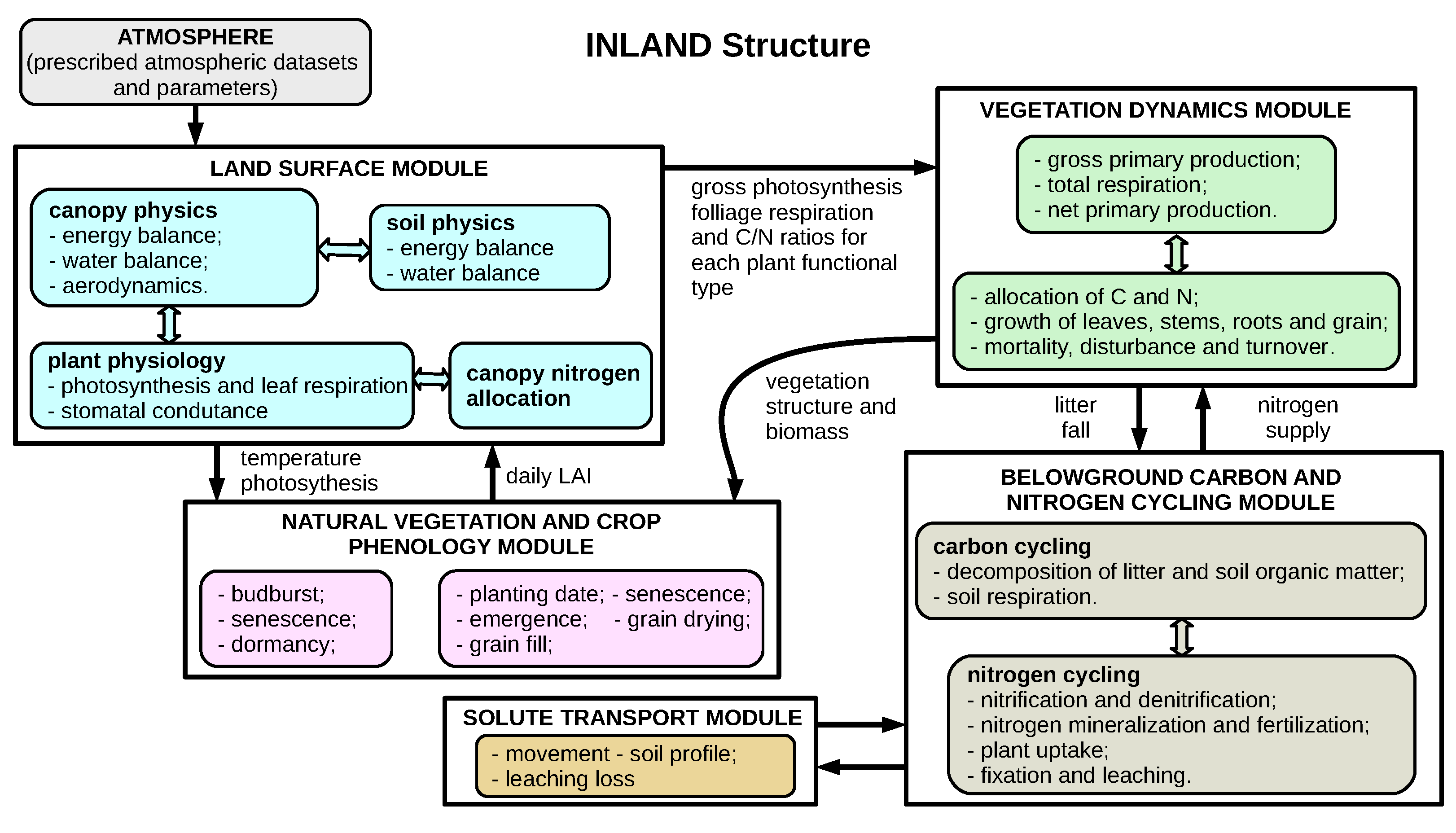


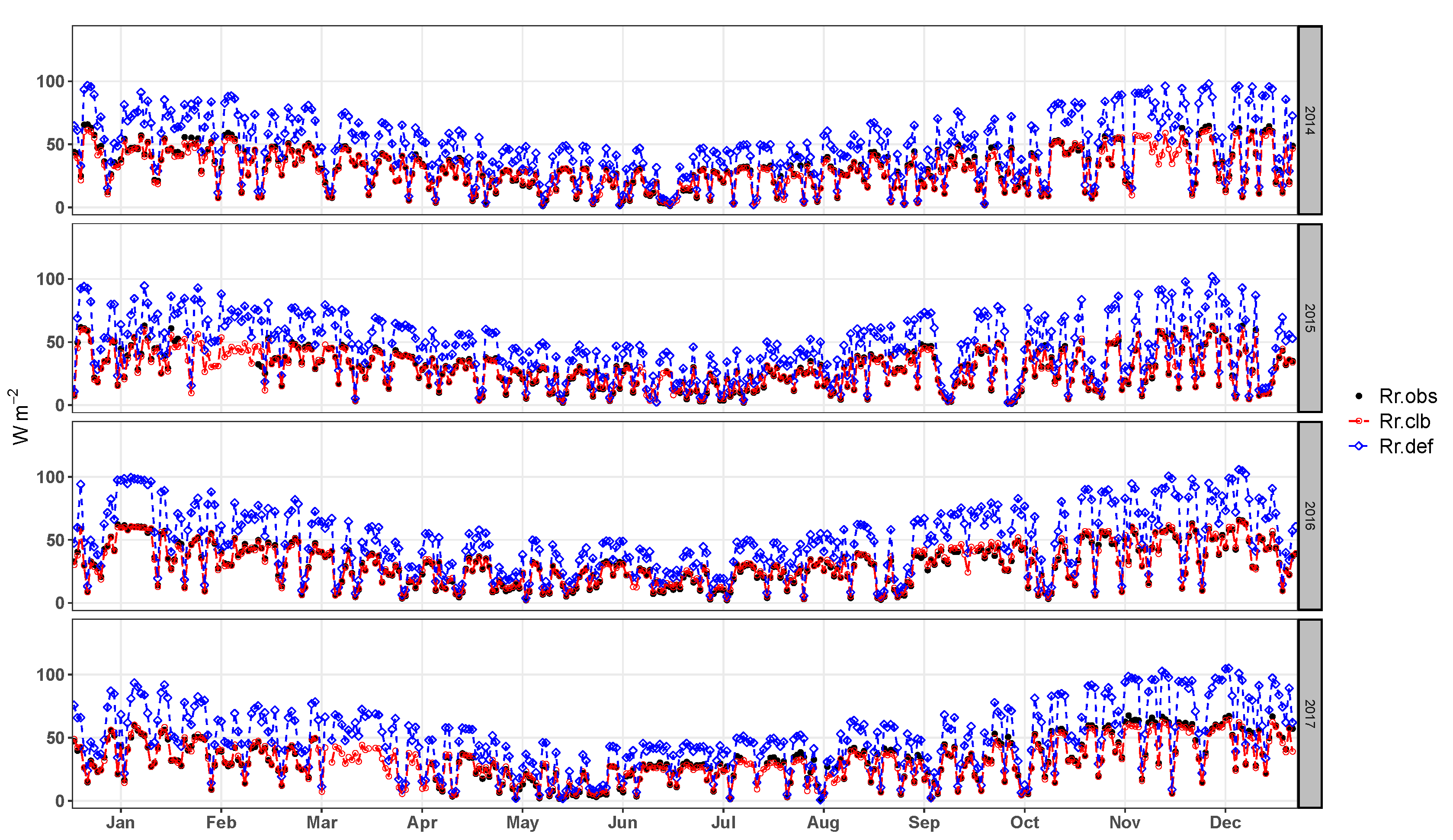
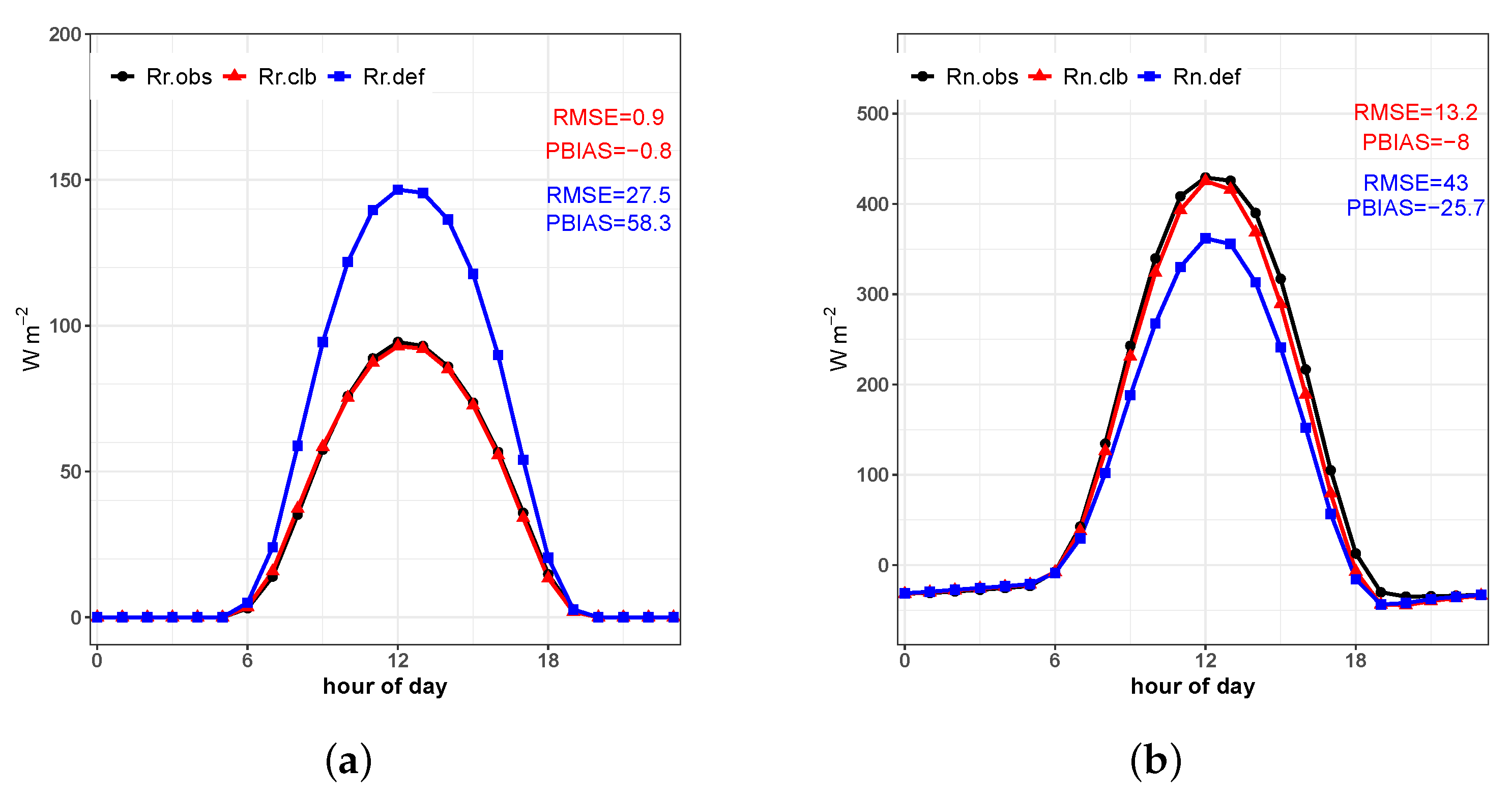

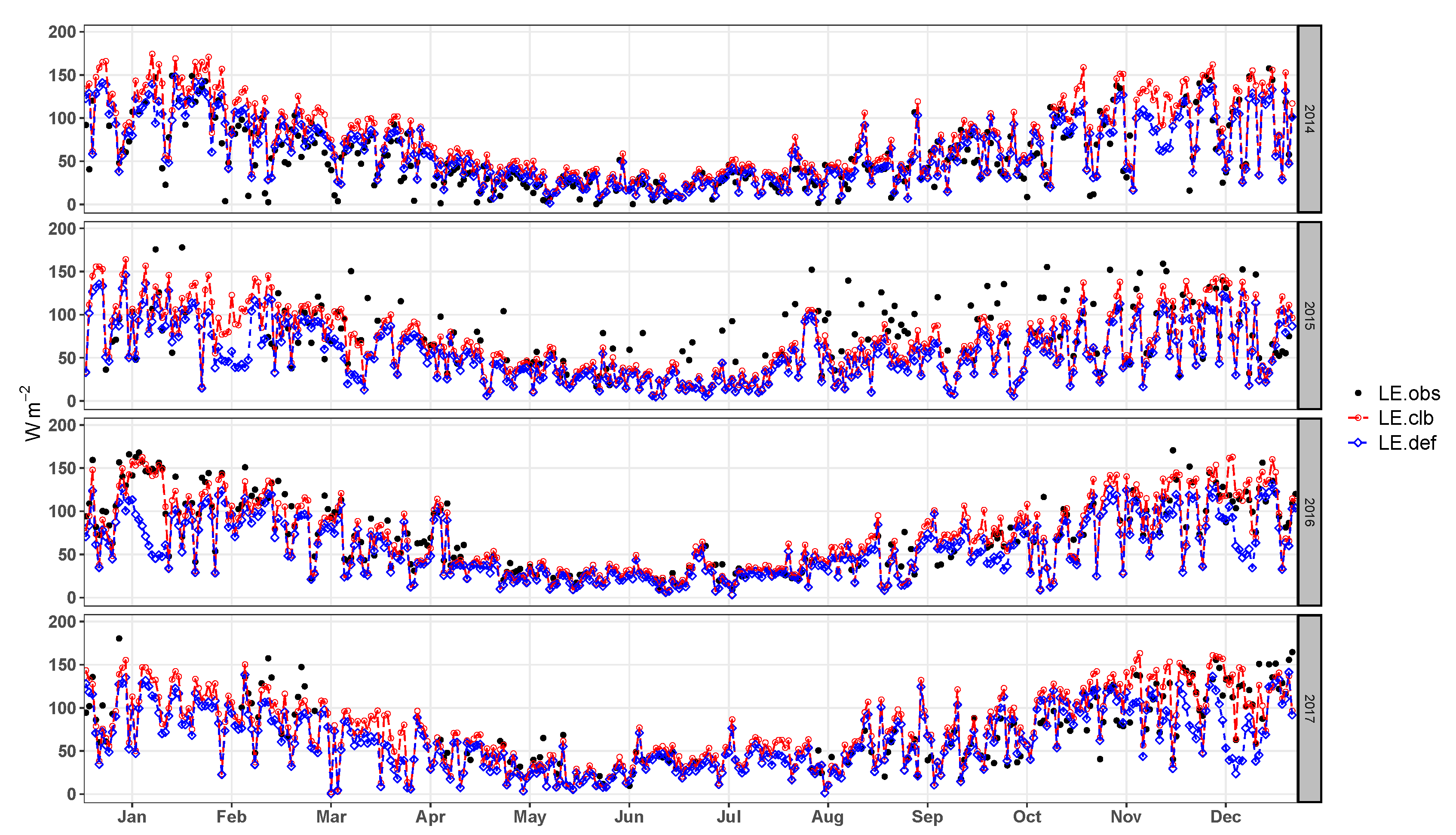
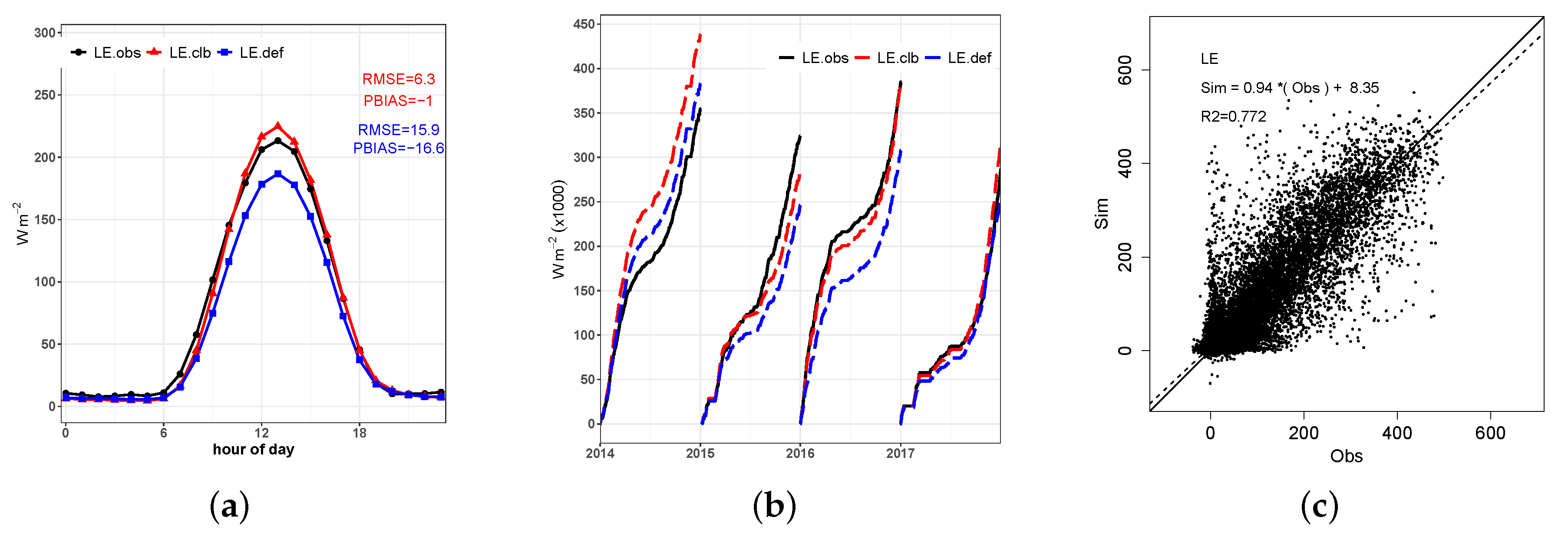
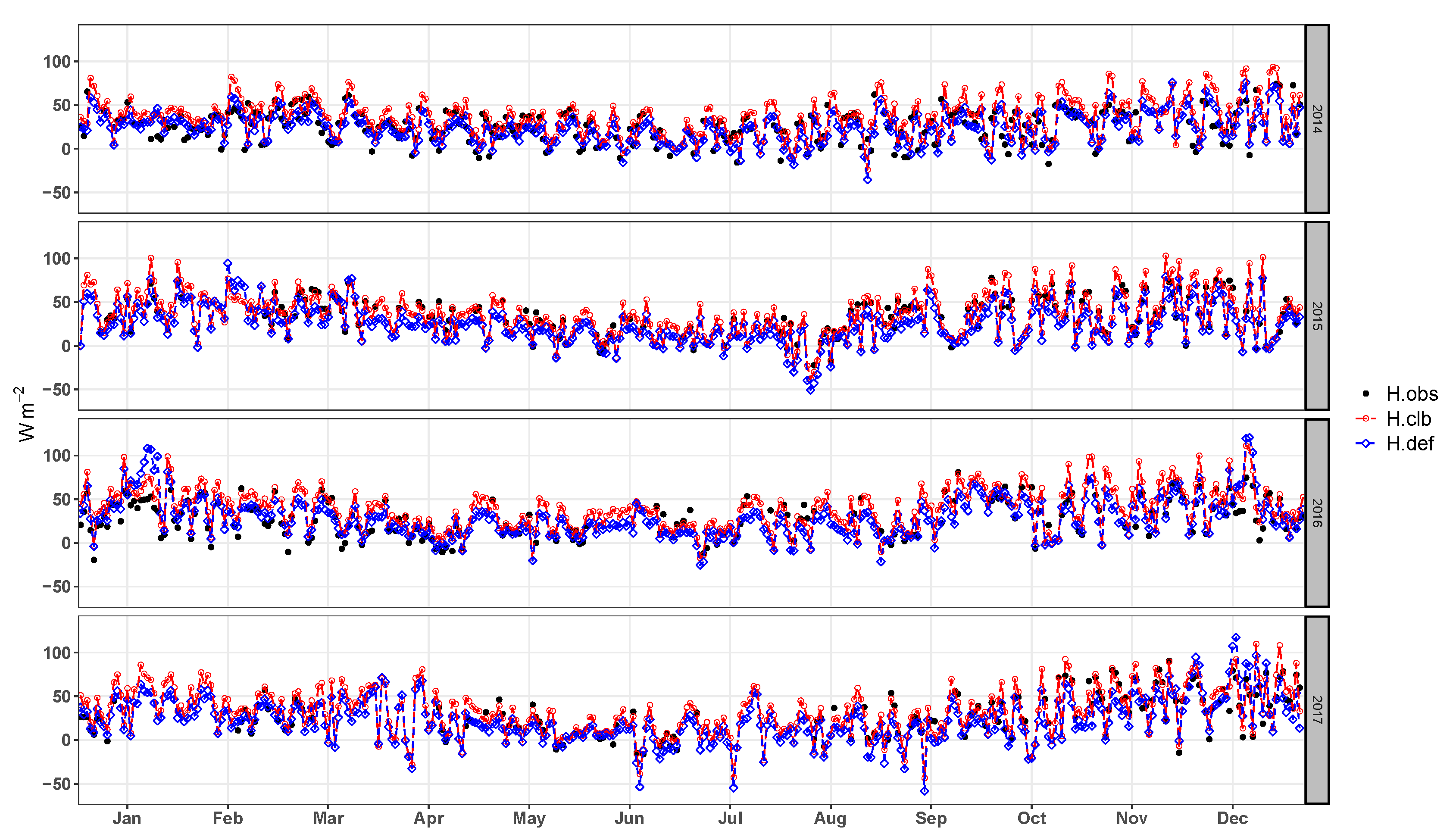
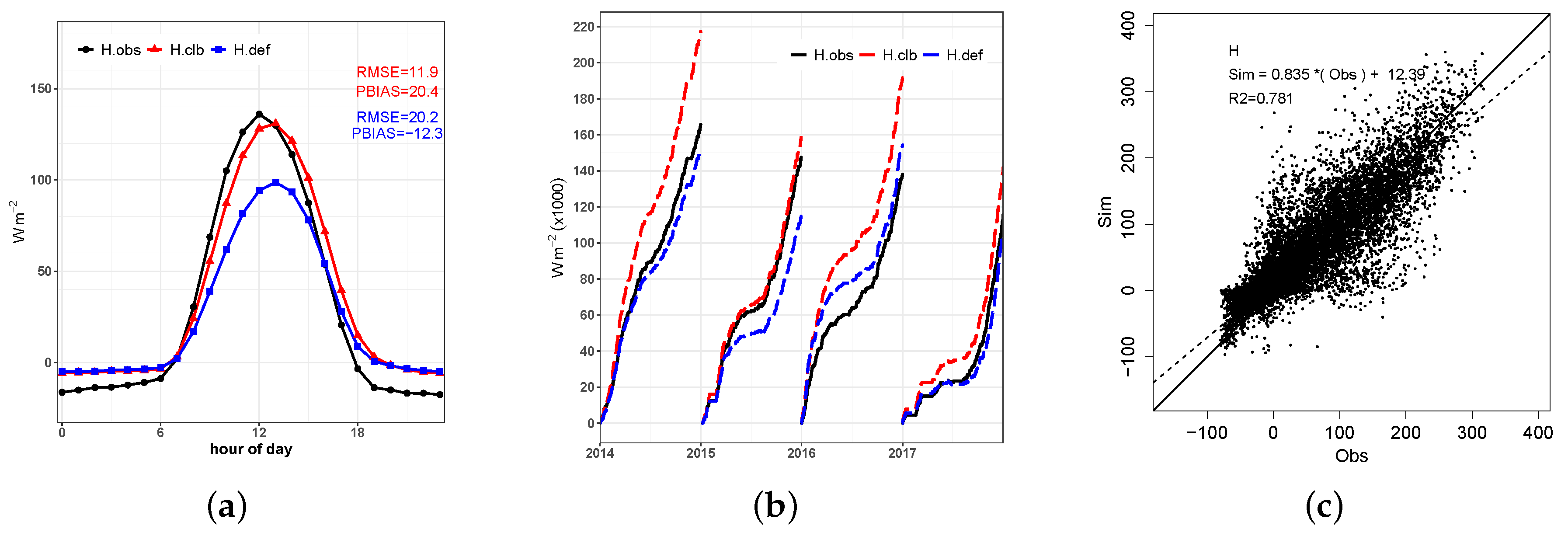
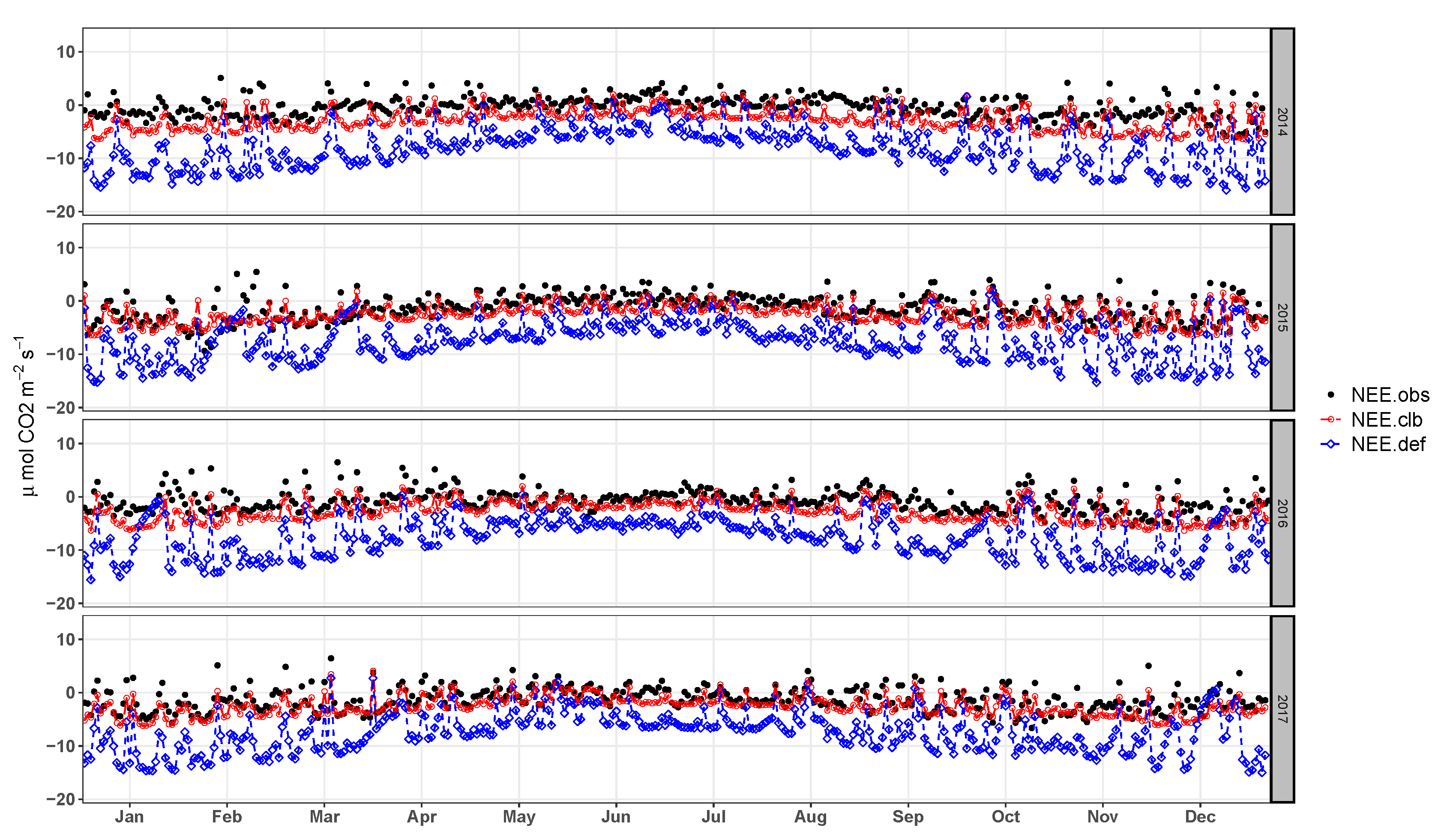
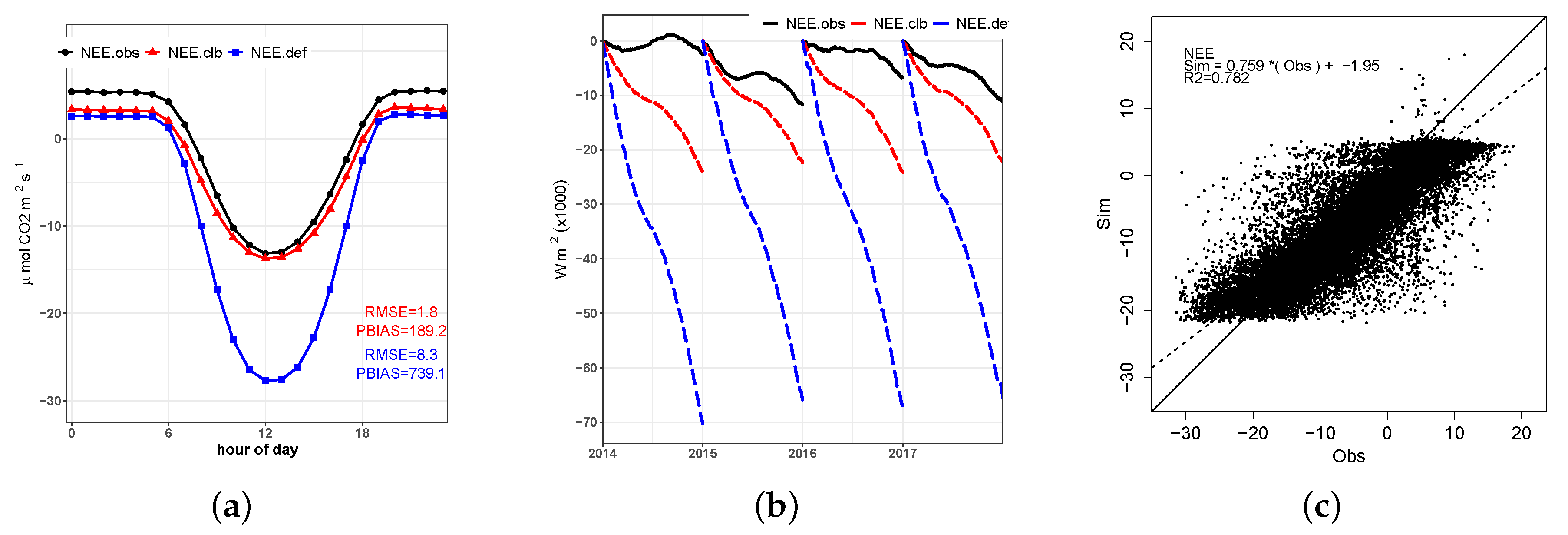
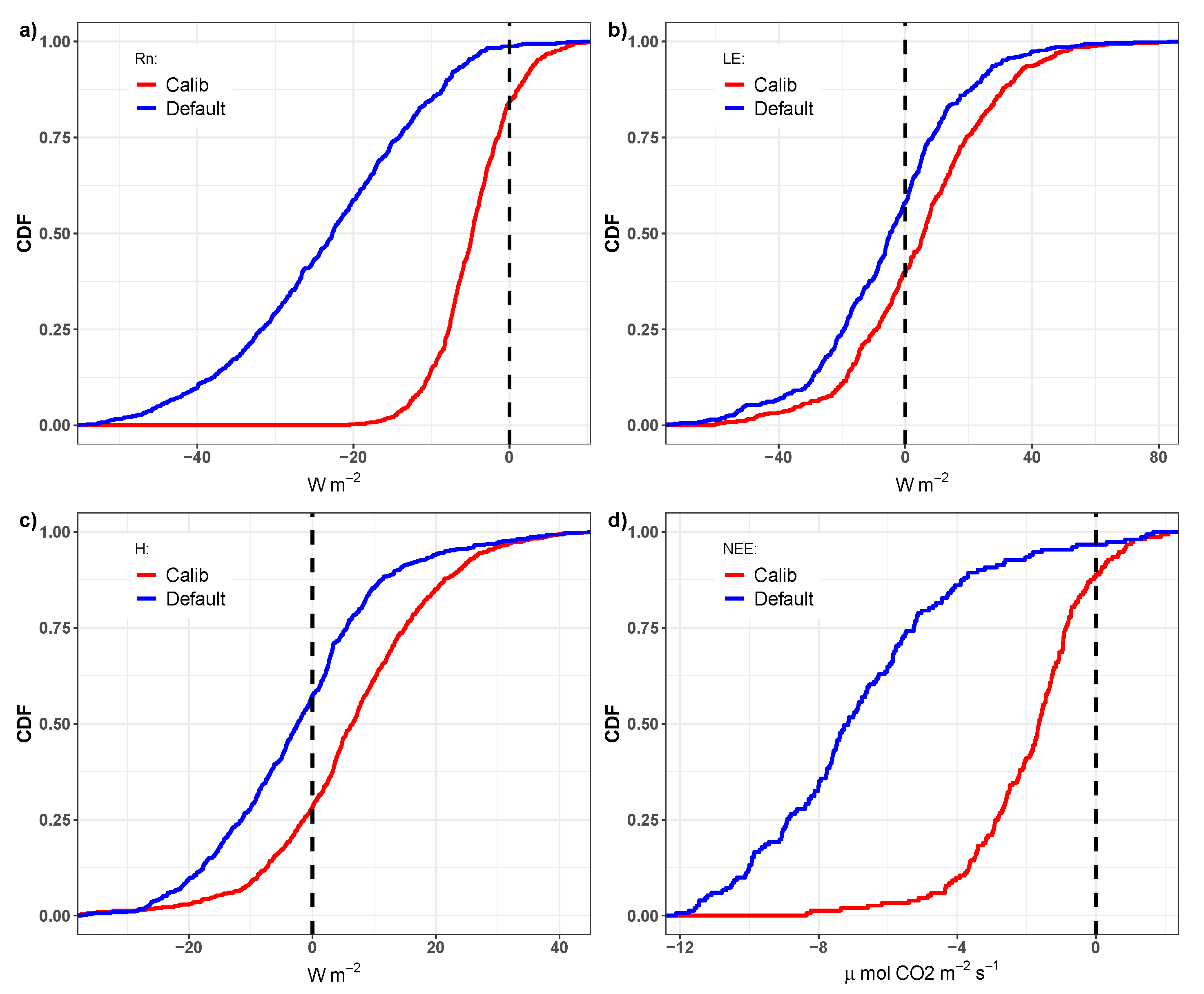
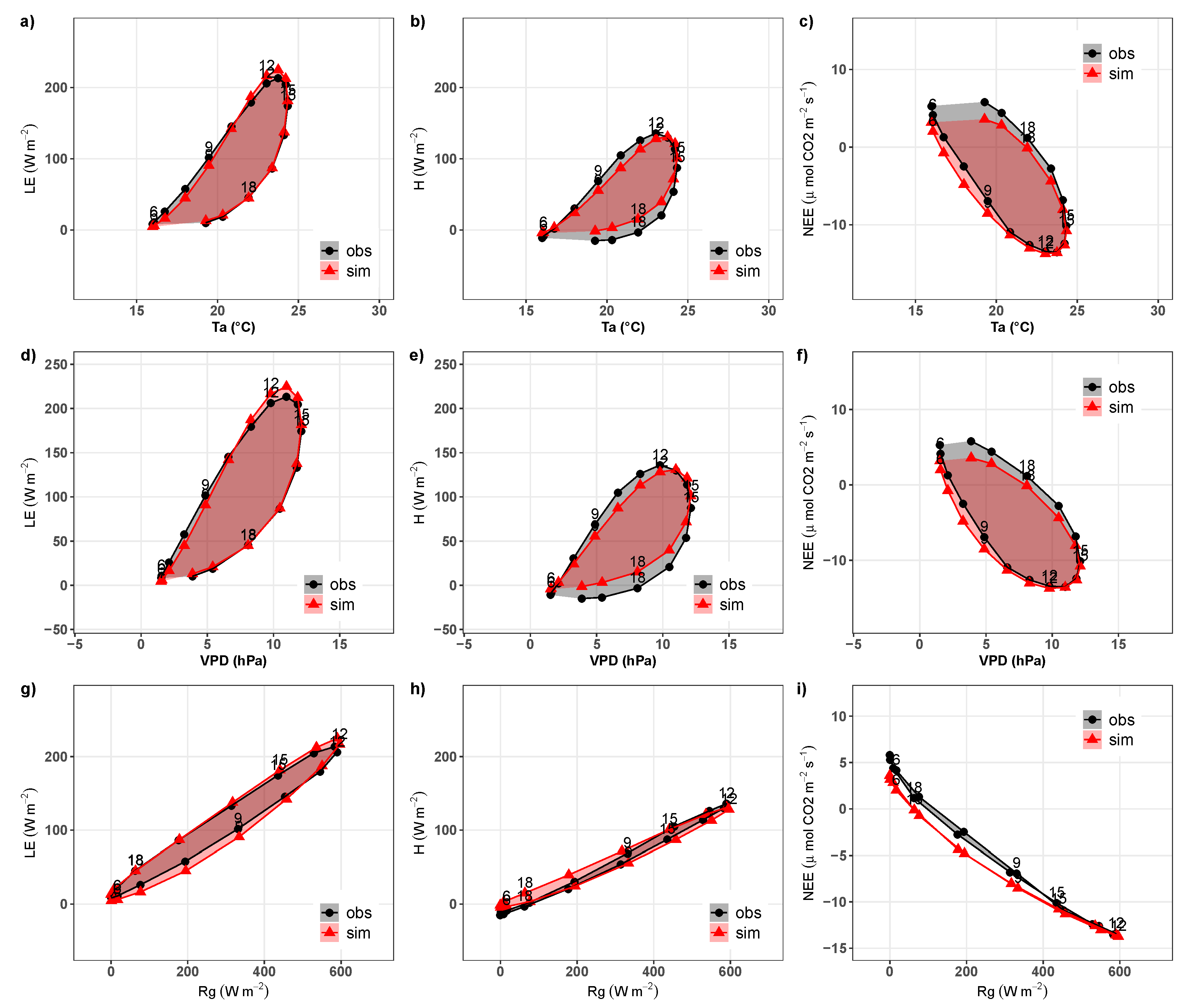
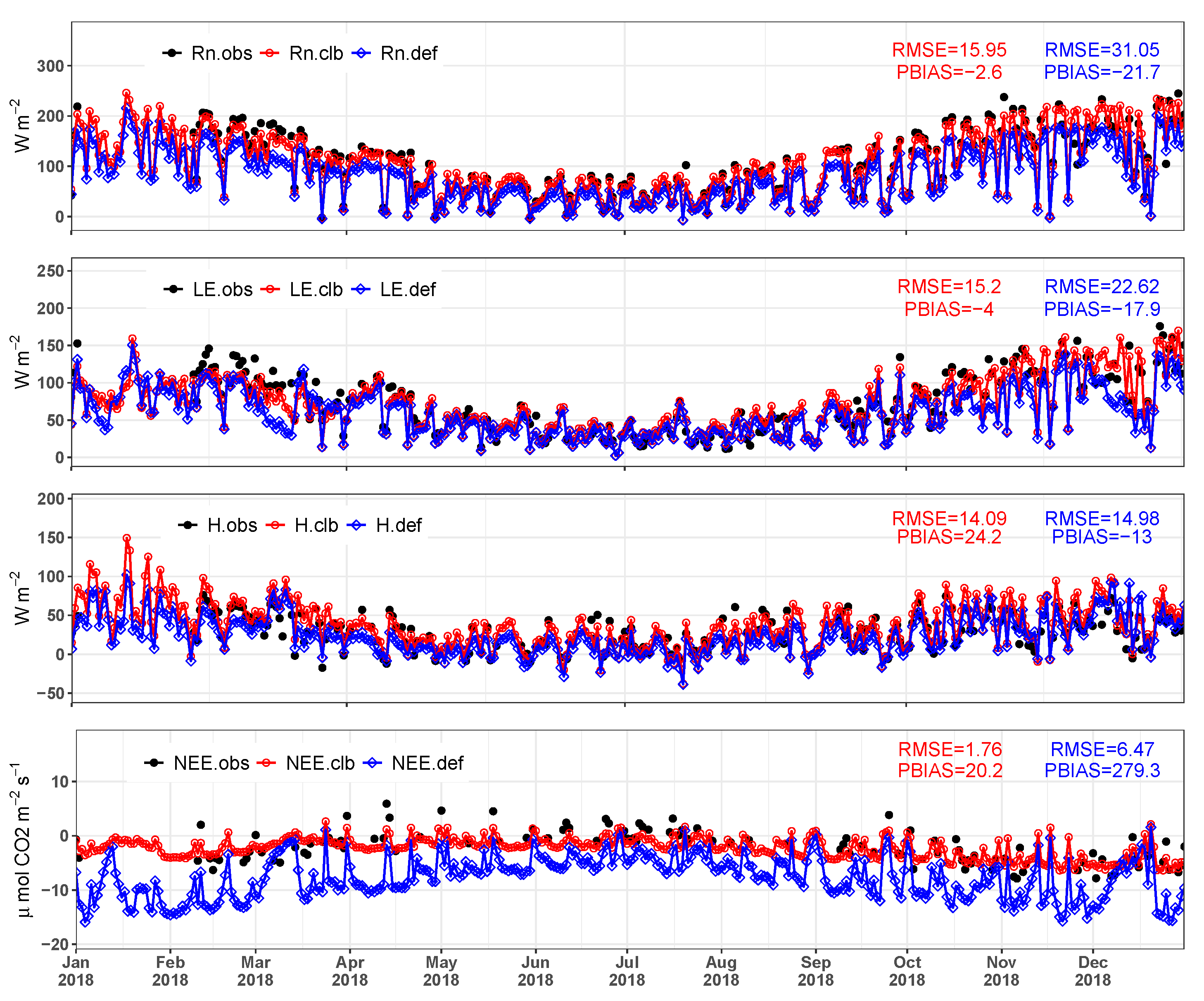
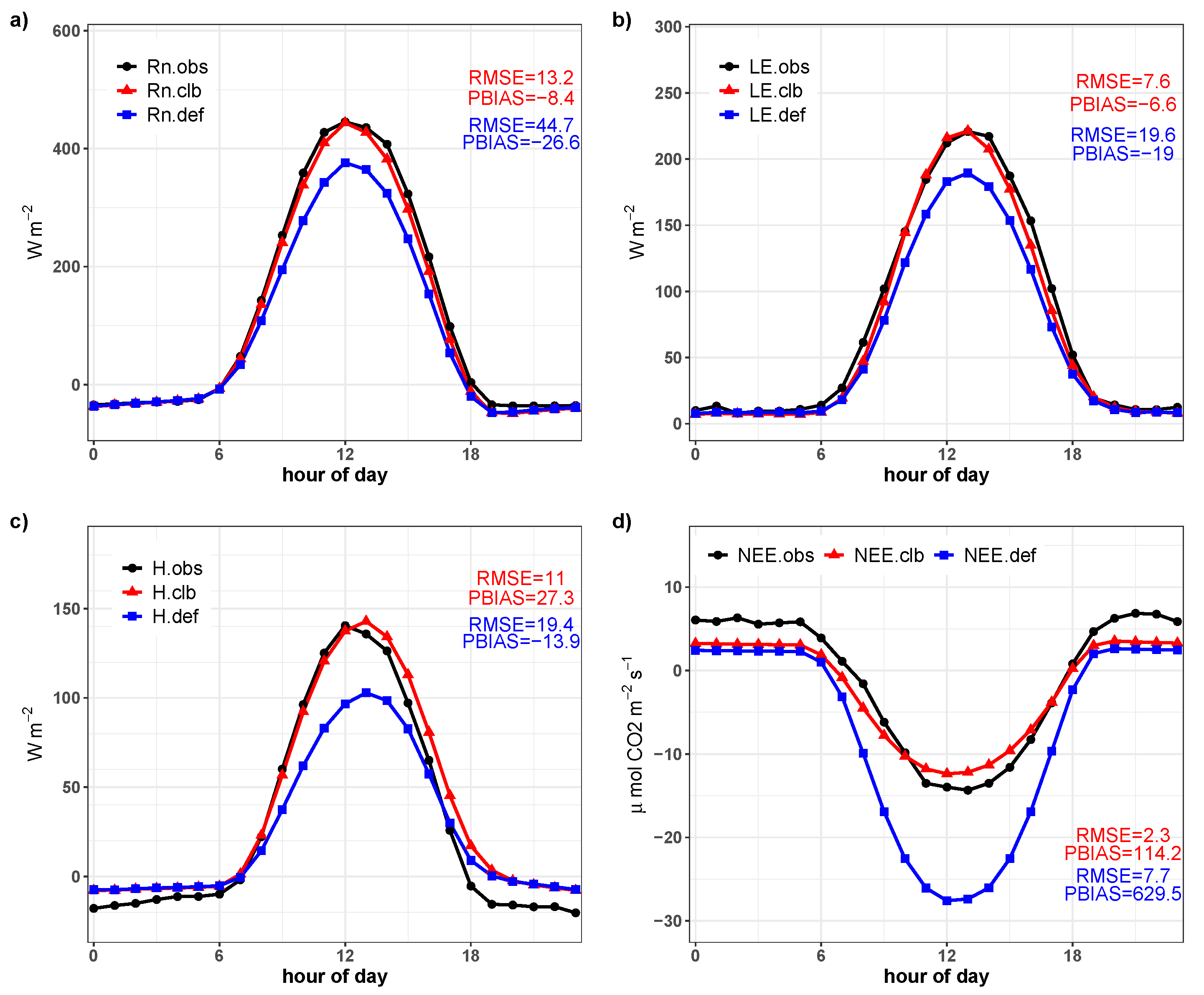
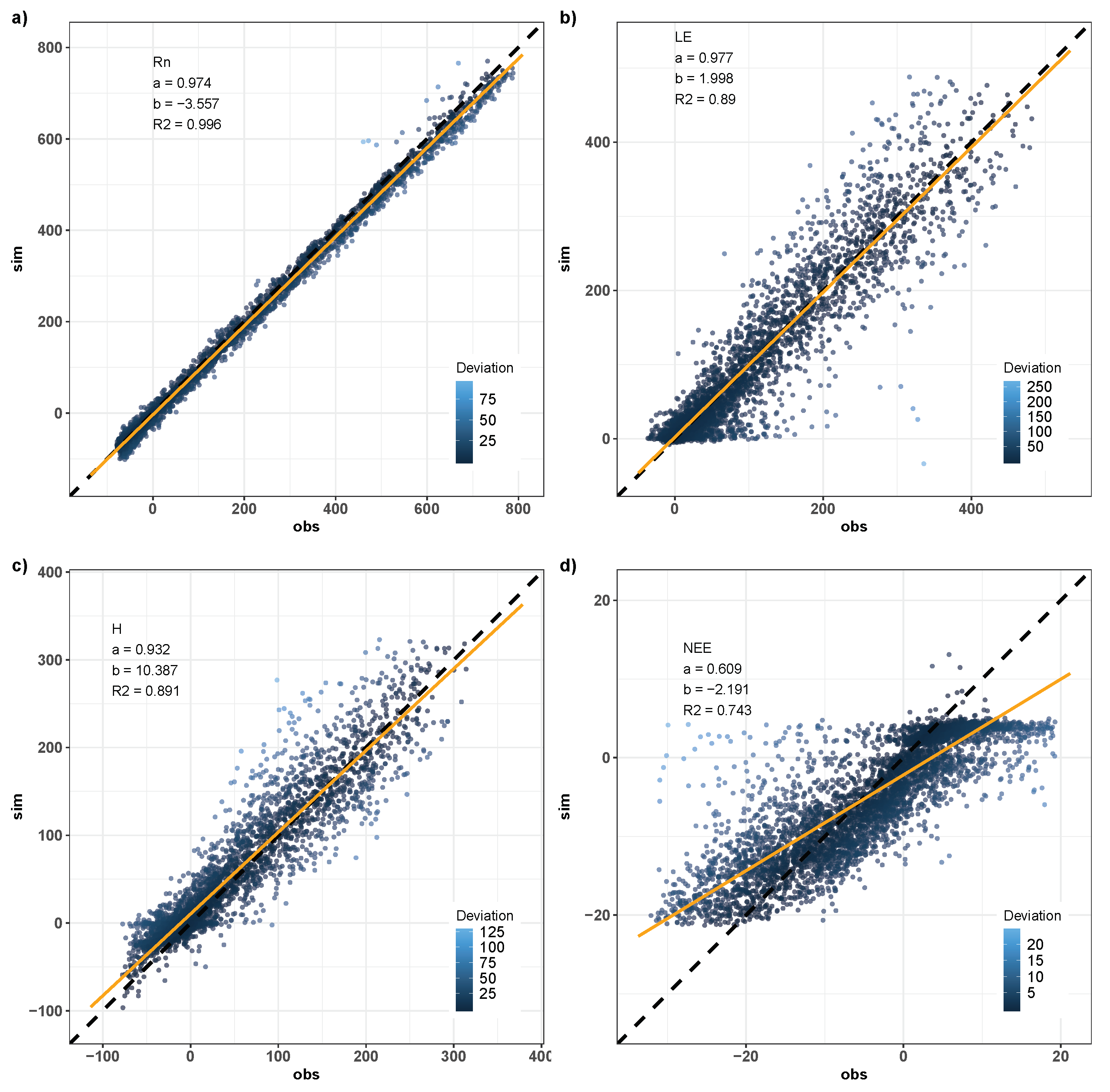
| Criteria | Name | Formulation | Optimal Value |
|---|---|---|---|
| Root-mean-squared error | 0 | ||
| Amplitude of the daily average cycle error | 0 | ||
| Mean absolute error | 0 | ||
| Nash–Sutcliffe efficiency | 1 | ||
| Percentual Bias | 0 | ||
| Coefficient of determination | 1 |
| Level 1: Rr (RMSE, ACD) | |||
|---|---|---|---|
| Parameters | Default | Range | Calibrated |
| : leaf/stem reflectance (VIS) for lower canopy | 0.062 | 0.01–0.25 | 0.136 |
| : leaf/stem transmittance (VIS) for lower canopy | 0.07 | 0.01–0.25 | 0.230 |
| : leaf/stem reflectance (NIR) for lower canopy | 0.60 | 0.2–0.5 | 0.273 |
| : leaf/stem transmittance (NIR) for lower canopy | 0.25 | 0.01–0.4 | 0.314 |
| : leaf/stem reflectance (VIS) for upper canopy | 0.062 | 0.01–0.25 | 0.091 |
| : leaf/stem transmittance (VIS) for upper canopy | 0.05 | 0.01–0.25 | 0.026 |
| : leaf/stem reflectance (NIR) for upper canopy | 0.4 | 0.2–0.5 | 0.373 |
| : leaf/stem transmittance (NIR) for upper canopy | 0.2 | 0.01–0.4 | 0.112 |
| : upper canopy leaf orientation factor | 0.0 | −0.2–0.2 | 0.018 |
| : lower canopy leaf orientation factor | −0.05 | −0.2–0.2 | 0.076 |
| : coefficient to calculate canopy emissivity | 1.0 | 1.0–20 | 7.965 |
| Level 2: LE, NEE, H (RMSE) | |||
| Parameters | Default | Range | Calibrated |
| : coefficient of the zero-plane displacement height | 0.7 | 0.1–0.9 | 0.644 |
| : maximum rate of carboxylation at 15 C | 25 | 15–15 | 9.474 |
| m: coefficient of stomatal conductance | 8.0 | 6.0–9.0 | 6.607 |
| : upper canopy stems per unit area | 2.63 | 1.0–3.0 | 1.928 |
| : root profile parameter (lower canopy) | 0.950 | 0.98–0.999 | 0.9933 |
| : root profile parameter (upper canopy) | 0.997 | 0.98–0.999 | 0.990 |
| : temperature stress coefficient for (above-ground biomass) | 3500 | 2000–5000 | 2726.360 |
| : temperature stress coefficient for (soil biomass) | 3500 | 2000–5000 | 4131.414 |
| : coefficient of roots respiration | 1.25 | 0.5–3.0 | 2.766 |
| : coefficient of stems respiration | 0.0125 | 0.01–0.05 | 0.049 |
| : temperature stress coefficient for | 3500 | 1000–7000 | 6334.915 |
| : coefficient for soil water stress | −5.0 | −6.0–−1.0 | −3.663 |
| : carbon in the litter stored in the leaves (structural) | 0.027 | 0.01–0.1 | 0.036 |
| : carbon in the litter stored in the thin roots (structural) | 0.0411 | 0.02–0.1 | 0.088 |
| : carbon in the litter stored in the stems (structural) | 0.001 | 0.001–0.2 | 0.125 |
| : soil carbon (protected humus) | 0.1198 | 0.1–2.0 | 1.871 |
| : soil carbonl (unprotected humus) | 5.3879 | 1.0–6.0 | 1.697 |
| : decay factor of the carbon reservoirs | 1.0 | 0.8–1.5 | 1.296 |
| : fraction of carbon lost due to plant development | 0.3 | 0.1–0.9 | 0.663 |
| : foliar biomass turnover time constant | 1.25 | 0.5–1.5 | 0.884 |
| : specific leaf area | 20.0 | 1.0–30.0 | 24.525 |
| Rn | Rr | LE | H | NEE | ||||||
|---|---|---|---|---|---|---|---|---|---|---|
| clb | def | clb | def | clb | def | clb | def | clb | def | |
| RMSE | 14.84 | 27.78 | 2.00 | 19.88 | 26.06 | 29.02 | 16.46 | 15.88 | 2.32 | 7.37 |
| PBIAS | −1.40 | −20.00 | −1.00 | 57.70 | 2.80 | −13.40 | 23.40 | −8.40 | 189.20 | 739.10 |
| MAE | 8.59 | 24.22 | 1.40 | 17.62 | 19.29 | 21.29 | 12.45 | 12.09 | 1.90 | 6.81 |
| NSE | 0.94 | 0.79 | 0.98 | −0.53 | 0.59 | 0.49 | 0.41 | 0.46 | −0.13 | −10.32 |
| R2 | 0.94 | 0.93 | 0.99 | 0.98 | 0.64 | 0.55 | 0.62 | 0.54 | 0.52 | 0.41 |
Publisher’s Note: MDPI stays neutral with regard to jurisdictional claims in published maps and institutional affiliations. |
© 2020 by the authors. Licensee MDPI, Basel, Switzerland. This article is an open access article distributed under the terms and conditions of the Creative Commons Attribution (CC BY) license (http://creativecommons.org/licenses/by/4.0/).
Share and Cite
Goergen, G.; Valdés, R.H.; Degrazia, G.A.; Gotuzzo, R.A.; Herdies, D.L.; de Gonçalves, L.G.G.; Roberti, D.R. Energy and CO2 Fluxes over Native Fields of Southern Brazil through Multi-Objective Calibration of INLAND Model. Geosciences 2020, 10, 479. https://doi.org/10.3390/geosciences10120479
Goergen G, Valdés RH, Degrazia GA, Gotuzzo RA, Herdies DL, de Gonçalves LGG, Roberti DR. Energy and CO2 Fluxes over Native Fields of Southern Brazil through Multi-Objective Calibration of INLAND Model. Geosciences. 2020; 10(12):479. https://doi.org/10.3390/geosciences10120479
Chicago/Turabian StyleGoergen, Guilherme, Roilan Hernández Valdés, Gervásio Annes Degrazia, Ricardo Acosta Gotuzzo, Dirceu Luis Herdies, Luis Gustavo Gonçalves de Gonçalves, and Débora Regina Roberti. 2020. "Energy and CO2 Fluxes over Native Fields of Southern Brazil through Multi-Objective Calibration of INLAND Model" Geosciences 10, no. 12: 479. https://doi.org/10.3390/geosciences10120479
APA StyleGoergen, G., Valdés, R. H., Degrazia, G. A., Gotuzzo, R. A., Herdies, D. L., de Gonçalves, L. G. G., & Roberti, D. R. (2020). Energy and CO2 Fluxes over Native Fields of Southern Brazil through Multi-Objective Calibration of INLAND Model. Geosciences, 10(12), 479. https://doi.org/10.3390/geosciences10120479





